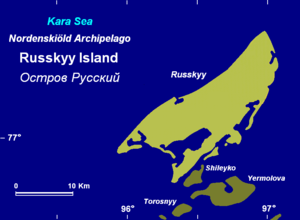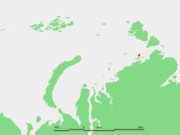
Russky Island (Kara Sea)
Encyclopedia


Kara Sea
The Kara Sea is part of the Arctic Ocean north of Siberia. It is separated from the Barents Sea to the west by the Kara Strait and Novaya Zemlya, and the Laptev Sea to the east by the Severnaya Zemlya....
. It is located in the Litke Islands subgroup of the Nordenskiöld Archipelago
Nordenskiöld Archipelago
The Nordenskiöld Archipelago or Nordenskjold Archipelago is a very large and complex cluster of islands in the eastern region of the Kara Sea. Its eastern limit lies west of the Taymyr Peninsula....
. With and area of 309 km², Russky is the biggest island in the whole archipelago. At a latitude of 77° 03' N, it is also the northernmost island of the group.
Administratively Russky Island belongs to the Krasnoyarsk Krai
Krasnoyarsk Krai
Krasnoyarsk Krai is a federal subject of Russia . It is the second largest federal subject after the Sakha Republic, and Russia's largest krai, occupying an area of , which is 13% of the country's total territory. The administrative center of the krai is the city of Krasnoyarsk...
, of the Russian Federation. It is also part of the Great Arctic State Nature Reserve
Great Arctic State Nature Reserve
The Great Arctic State Nature Reserve is a nature reserve in Krasnoyarsk Krai, Russia...
, the largest nature reserve of Russia.
History
In 1935, during Soviet times, a weather station was established in Russky Island. This outpost was part of the building of a modern polar station network undertaken by the Chief Directorate of the Northern Sea RouteChief Directorate of the Northern Sea Route
The Chief Directorate of the Northern Sea Route , also known as Glavsevmorput, was a Soviet government organization in charge of the naval Northern Sea Route, established in January 1932 and dissolved in 1964.-History:The organization traces its roots to AO Komseveroput, a shipping company...
(GUSMP) between 1932 and 1940. Besides taking meteorological measurements, the purpose of Russky Island's station was to monitor Arctic navigation along the Northern Sea Route
Northern Sea Route
The Northern Sea Route is a shipping lane officially defined by Russian legislation from the Atlantic Ocean to the Pacific Ocean specifically running along the Russian Arctic coast from Murmansk on the Barents Sea, along Siberia, to the Bering Strait and Far East. The entire route lies in Arctic...
route. One of the route's branches coming from the Vilkitsky Strait
Vilkitsky Strait
Vilkitsky Strait is a strait between the Taimyr Peninsula and Bolshevik Island in the Severnaya Zemlya archipelago. The strait connects the Kara and Laptev Seas. The length of the Vilkitsky Strait is 104 km, the width – approx. 55 km, and the depth – between 32 and 210 m. It is...
passed right off Russky Island's NW shores. For many years this lonely Arctic station was the only permanently inhabited place in the whole Nordenskiöld Archipelago.
In 1939 the workers of the Russky Island station made the measuring of the ice layer and the height of embacles on the perpendicular to the bank section as a present to the 18th Congress of the Communist Party of the Soviet Union
18th Congress of the All-Union Communist Party (b)
The 18th Congress of the Russian Communist Party was held during 10-21 March 1939 in Moscow. This is the first Congress to be dominated by the "purified" leadership of the Soviet Union after the Great Purge...
.
On the 25th August 1942, during Operation Wunderland
Operation Wunderland
Operation Wunderland was a large-scale operation undertaken in summer 1942 by the Kriegsmarine during World War II in the waters of the Northern Sea Route close to the Arctic Ocean...
, Kriegsmarine
Kriegsmarine
The Kriegsmarine was the name of the German Navy during the Nazi regime . It superseded the Kaiserliche Marine of World War I and the post-war Reichsmarine. The Kriegsmarine was one of three official branches of the Wehrmacht, the unified armed forces of Nazi Germany.The Kriegsmarine grew rapidly...
heavy cruiser Admiral Scheer fell upon the Russian icebreaker Sibiryakov
Icebreaker Sibiryakov
The icebreaker Sibiryakov was a Soviet ship which was active in the Russian Arctic during the 1930s. She was built in 1909 in Glasgow and was originally the Newfoundland sealing steamer Bellaventure. After being purchased by Russia in 1916, she was renamed the Sibiryakov...
(under the command of Captain Kacharev) right off the northwest coast of Russky Island while prowling the waters off the northern end of the Nordenskiöld Archipelago
Nordenskiöld Archipelago
The Nordenskiöld Archipelago or Nordenskjold Archipelago is a very large and complex cluster of islands in the eastern region of the Kara Sea. Its eastern limit lies west of the Taymyr Peninsula....
. After opposing heroic resistance, the Sibiryakov was sunk in an unequal battle. Then Admiral Scheer headed southwest in order to attack the Soviet military installations at Dikson
Dikson
Dikson Island , initially Dickson, is the name of an island in Krasnoyarsk Krai, Russia, situated in the Kara Sea near the mouth of the Yenisei River. A nearby urban-type settlement of Dikson, which functions as a port and hydrometeorological centre is located at...
.
Scientific research on Russky Island, like the monitoring of animal species on the island (lemming
Lemming
Lemmings are small rodents, usually found in or near the Arctic, in tundra biomes. They are subniveal animals, and together with voles and muskrats, they make up the subfamily Arvicolinae , which forms part of the largest mammal radiation by far, the superfamily Muroidea, which also includes rats,...
, purple sandpiper
Purple Sandpiper
The Purple Sandpiper, Calidris, Arquatella or Erolia maritima is a small shorebird.Adults have short yellow legs and a medium thin dark bill with a yellow base. The body is dark on top with a slight purplish gloss and mainly white underneath. The breast is smeared with grey and the rump is black...
, turnstone
Turnstone
Turnstones are the bird species in the genus Arenaria in the family Scolopacidae. They are closely related to calidrid sandpipers and might be considered members of the tribe Calidriini....
, sanderling
Sanderling
The Sanderling is a small wader. It is a circumpolar Arctic breeder, and is a long-distance migrant, wintering south to South America, South Europe, Africa, and Australia...
, and little stint
Little Stint
The Little Stint, Calidris minuta , is a very small wader. It breeds in arctic Europe and Asia, and is a long-distance migrant, wintering south to Africa and south Asia...
) was conducted after the breakup of the Soviet Union, but the Arctic station was closed in 1999.

